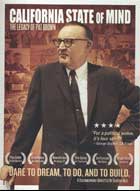
California State of Mind: The Legacy of Pat Brown 2012
Distributed by Good Docs
Produced by Fire of Life Films
Directed by Sascha Rice
DVD , color, Theatrical version- 86 min; Educational version-56 min. (both on same disc)
Jr. High - General Adult
California Politics, Progressive Government, Democratic Party
Date Entered: 07/11/2013
Reviewed by Christopher Lewis, American University Library, American UniversityIn his first term as governor of California from 1958-1962, Governor Pat Brown established the tuition-free state university system; established a 700-mile long water supply system that brought water to farmers in the central valley and fed the growth of Los Angeles; got a fair housing bill passed; and began adding hundreds of miles to the interstate highway system. Each of these feats was accomplished in the face of staunch opposition but Governor Brown was a deft negotiator and pragmatic leader. He successfully communicated his vision of the future of California and was able to build bi-partisan support. The speed with which he undertook these massive programs would be almost unheard of today.
In Brown’s second term, the social unrest surrounding civil rights and the Vietnam War had enflamed the nation and some of the hottest spots were in California. Berkeley was the site of the nation’s most fervent anti-war protests. In Los Angeles, the overturn of Brown’s Fair Housing laws provided a catalyst for intense rioting. Police reaction in both cities exacerbated the situations. The newly-formed United Farmworkers, under the leadership of Cesar Chavez, were organizing against poor working conditions in the fields. Brown’s progressive policies were a casualty of the era. Social unrest stirred up fears in the public and Brown was viewed as soft on crime. Already tagged as indecisive following a difficult death penalty decision in his first term, Brown lost his bid for a third term to the law-and-order anti-big-government campaign of Ronald Reagan.
His failed re-election bid marked the end of Brown’s political life but his legacy continued. His son Jerry succeeded Reagan as governor and two decades later is governor again. Brown’s daughter, Kathleen, served as California’s State Treasurer in the 1990s.
A California State of Mind was directed by Brown’s granddaughter, Sascha Rice, the daughter of Kathleen Brown. The film is mostly the story of Pat Brown though it encompasses the work that has been carried on by his children. Pat Brown deserves to be remembered as a paragon of pragmatic governance. His record has been overshadowed somewhat by the anti-government wave that rolled in with his successor Ronald Reagan and the later dismantling of his educational efforts by statewide ballot initiatives. However Brown is a noteworthy example of how much a single leader can accomplish with the necessary vision and resolve. This film does a huge service to illuminate Brown’s career and provide a coherent record of his successes and failures. Given that the filmmaker is his granddaughter there are some fawning and personal memories but this is no hagiography. It’s clear that Brown wasn’t universally loved. Rice has gathered much archival footage and commentary from others including Willie Brown, Nancy Pelosi, Dianne Feinstein, and Tom Brokaw who believes Brown will be long-remembered as “the godfather of modern California.” Brown’s story should serve as an inspiration for anyone weary of the never-ending political scrums that have come to be identified with state and national politics. There is no other DVD available on the career of Pat Brown and this is a worthy addition. It’s a highly recommended purchase for every library in California and any university with government and/or American history departments.
The DVD also includes three bonus features: Leadership Then and Now; Stories and Legacies; Debating the Death Penalty.